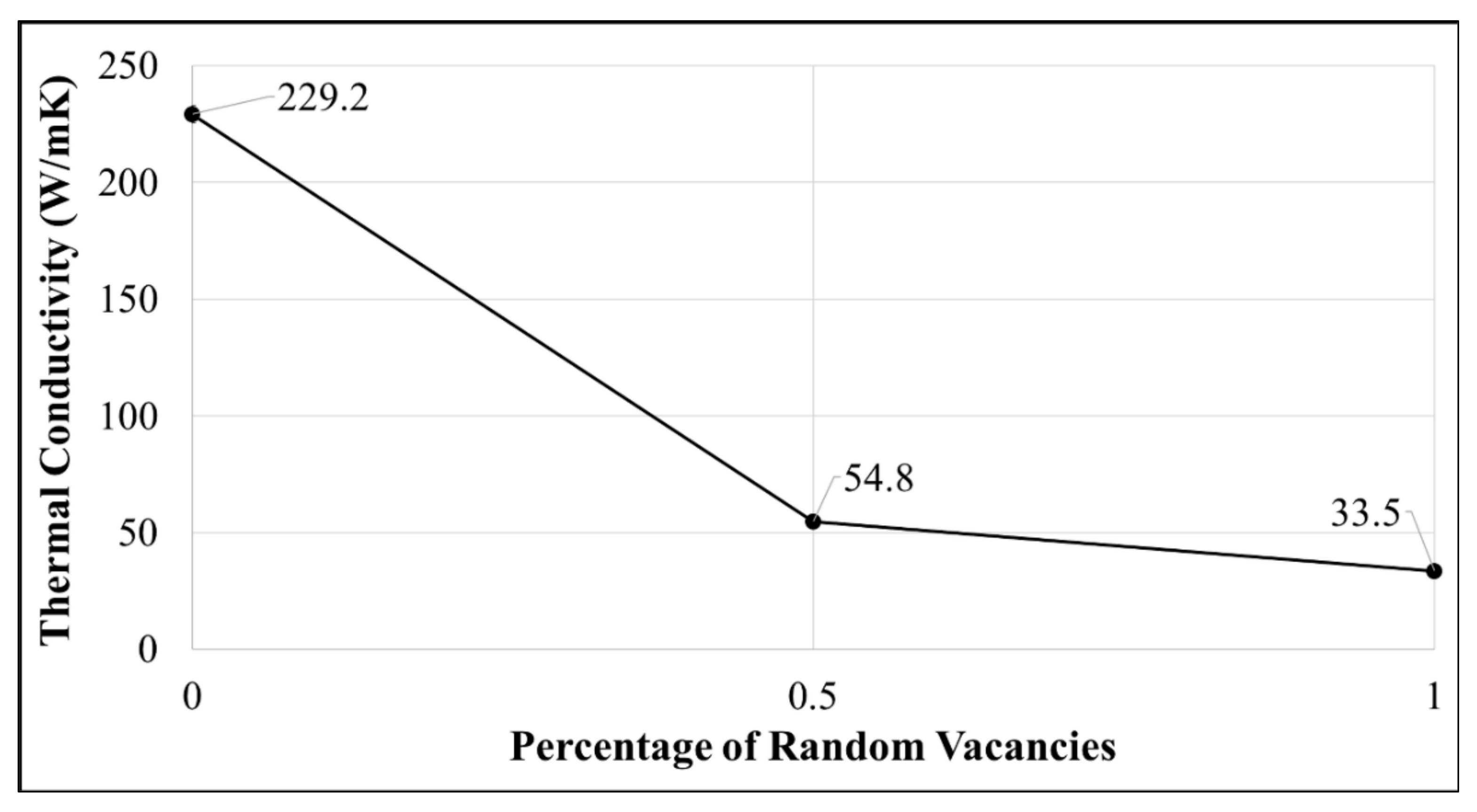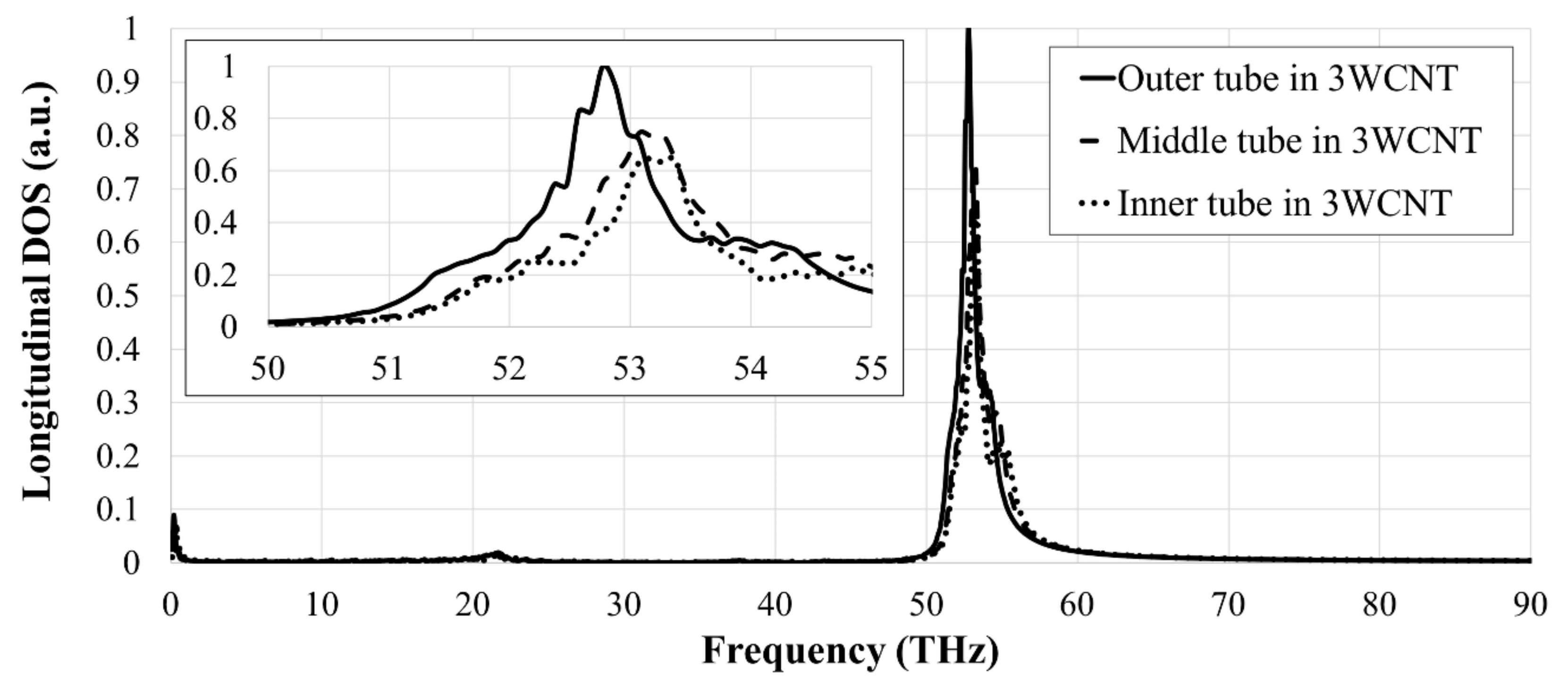Thermal Conductivity of Metal-Coated Tri-Walled Carbon Nanotubes in the Presence of Vacancies-Molecular Dynamics Simulations
Abstract
1. Introduction
2. Materials and Methods
3. Results and Discussion
4. Conclusions
Author Contributions
Funding
Acknowledgments
Conflicts of Interest
References
- Fujii, M.; Zhang, X.; Xie, H.; Ago, H.; Takahashi, K.; Ikuta, T.; Abe, H.; Shimizu, T. Measuring the Thermal Conductivity of a Single Carbon Nanotube. Phys. Rev. Lett. 2005, 95, 065502. [Google Scholar] [CrossRef]
- Marconnet, A.M.; Panzer, M.A.; Goodson, K.E. Thermal conduction phenomena in carbon nanotubes and related nanostructured materials. Rev. Modern Phys. 2013, 85, 1295–1326. [Google Scholar] [CrossRef]
- Aliev, A.E.; Lima, M.H.; Silverman, E.M.; Baughman, R.H. Thermal conductivity of multi-walled carbon nanotube sheets: Radiation losses and quenching of phonon modes. Nanotechnology 2010, 21, 035709. [Google Scholar] [CrossRef]
- Lindsay, L.; Broido, D.A.; Mingo, N. Diameter dependence of carbon nanotube thermal conductivity and extension to the graphene limit. Phys. Rev. B 2010, 82, 161402. [Google Scholar] [CrossRef]
- Berber, S.; Kwon, Y.K.; Tománek, D. Unusually High Thermal Conductivity of Carbon Nanotubes. Phys. Rev. Lett. 2000, 84, 4613–4616. [Google Scholar] [CrossRef] [PubMed]
- Osman, M.A.; Srivastava, D. Temperature dependence of the thermal conductivity of single-wall carbon nanotubes. Nanotechnology 2001, 12, 21–24. [Google Scholar] [CrossRef]
- Zhang, W.; Zhu, Z.; Wang, F.; Wang, T.; Sun, L.; Wang, Z. Chirality dependence of the thermal conductivity of carbon nanotubes. Nanotechnology 2004, 15, 936. [Google Scholar] [CrossRef]
- Che, J.; Çagin, T.; Goddard, W.A., III. Thermal conductivity of carbon nanotubes. Nanotechnology 2000, 11, 65. [Google Scholar] [CrossRef]
- Ohnishi, M.; Shiga, T.; Shiomi, J. Effects of defects on thermoelectric properties of carbon nanotubes. Phys. Rev. B 2017, 95, 155405. [Google Scholar] [CrossRef]
- Park, J.; Bifano, M.F.P.; Prakash, V. Sensitivity of thermal conductivity of carbon nanotubes to defect concentrations and heat-treatment. J. Appl. Phys. 2013, 113, 034312. [Google Scholar] [CrossRef]
- Pierret, R.F. Advanced Semiconductor Fundamentals, 2nd ed.; Neudeck, G.W., Pierret, R.F., Eds.; Pearson Education, Inc.: Bergen County, NJ, USA, 2002; Volume VI. [Google Scholar]
- Chen, G. Nanoscale Energy Transport and Conversion: A Parallel Treatment of Electrons, Molecules, Phonons, and Photons; Oxford University Press: Oxford, UK, 2005. [Google Scholar]
- Collins, P.G. Defects and Disorder in Carbon Nanotubes; Narlikar, A.V., Fu, Y.Y., Eds.; Oxford University Press: Oxford, UK, 2017; Volume 1. [Google Scholar]
- Fan, H.; Zhang, K.; Yuen, M.M.F. Effect of defects on thermal performance of carbon nanotube investigated by molecular dynamics simulation. In Proceedings of the 2006 International Conference on Electronic Materials and Packaging, Kowloon, China, 11–14 December 2006; pp. 1–4. [Google Scholar]
- Charlier, J.C. Defects in Carbon Nanotubes. Acc. Chem. Res. 2002, 35, 1063–1069. [Google Scholar] [CrossRef]
- Kotakoski, J.; Krasheninnikov, A.V.; Nordlund, K. Energetics, structure, and long-range interaction of vacancy-type defects in carbon nanotubes: Atomistic simulations. Phys. Rev. B 2006, 74, 245420. [Google Scholar] [CrossRef]
- Fan, Y.; Goldsmith, B.R.; Collins, P.G. Identifying and counting point defects in carbon nanotubes. Nat. Mater. 2005, 4, 906–911. [Google Scholar] [CrossRef] [PubMed]
- Marconnet, A.M.; Yamamoto, N.; Panzer, M.A.; Wardle, B.L.; Goodson, K.E. Thermal Conduction in Aligned Carbon Nanotube–Polymer Nanocomposites with High Packing Density. ACS Nano 2011, 5, 4818–4825. [Google Scholar] [CrossRef]
- Chien, S.K.; Yang, Y.T.; Chen, C.K. The effects of vacancy defects and nitrogen doping on the thermal conductivity of armchair (10, 10) single-wall carbon nanotubes. Solid State Commun. 2011, 151, 1004–1008. [Google Scholar] [CrossRef]
- Bi, K.; Chen, Y.; Yang, J.; Wang, Y.; Chen, M. Molecular dynamics simulation of thermal conductivity of single-wall carbon nanotubes. Phys. Lett. A 2006, 350, 150–153. [Google Scholar] [CrossRef]
- Eres, G.; Puretzky, A.A.; Geohegan, D.B.; Cui, H. In situ control of the catalyst efficiency in chemical vapor deposition of vertically aligned carbon nanotubes on predeposited metal catalyst films. Appl. Phys. Lett. 2004, 84, 1759–1761. [Google Scholar] [CrossRef]
- Varshney, V.; Lee, J.; Li, D.; Brown, J.S.; Farmer, B.L.; Voevodin, A.A.; Roy, A.K. Understanding thermal conductance across multi-wall carbon nanotube contacts: Role of nanotube curvature. Carbon 2017, 114, 15–22. [Google Scholar] [CrossRef]
- Cross, R.; Cola, B.A.; Fisher, T.; Xu, X.; Gall, K.; Graham, S. A metallization and bonding approach for high performance carbon nanotube thermal interface materials. Nanotechnology 2010, 21, 445705. [Google Scholar] [CrossRef]
- Hu, X.; Pan, L.S.; Gu, G.; Goodson, K.E. Superior Thermal Interfaces Made by Metallically Anchored Carbon Nanotube Arrays. In Proceedings of the ASME 2009 InterPACK Conference Collocated with the ASME 2009 Summer Heat Transfer Conference and the ASME 2009 3rd International Conference on Energy Sustainability, San Francisco, CA, USA, 19–23 July 2009; pp. 597–603. [Google Scholar]
- Stano, K.L.; Chapla, R.; Carroll, M.; Nowak, J.; McCord, M.; Bradford, P.D. Copper-Encapsulated Vertically Aligned Carbon Nanotube Arrays. ACS Appl. Mater. Interfaces 2013, 5, 10774–10781. [Google Scholar] [CrossRef]
- Cui, L.; Feng, Y.; Tang, J.; Tan, P.; Zhang, X. Heat conduction in coaxial nanocables of Au nanowire core and carbon nanotube shell: A molecular dynamics simulation. Int. J. Therm. Sci. 2016, 99, 64–70. [Google Scholar] [CrossRef]
- Smith, K.A.; Zbib, M.B.; Bahr, D.F.; Guinel, M.J.F. Elastic behavior of a core–shell metal–carbon nanotube composite foam. MRS Commun. 2014, 4, 77–81. [Google Scholar] [CrossRef]
- Hua, Z.; Liu, Y.; Yao, G.; Wang, L.; Ma, J.; Liang, L. Preparation and Characterization of Nickel-Coated Carbon Fibers by Electroplating. J. Mater. Eng. Perform. 2012, 21, 324–330. [Google Scholar] [CrossRef]
- Byeon, J.H.; Yoon, H.S.; Yoon, K.Y.; Ryu, S.K.; Hwang, J. Electroless copper deposition on a pitch-based activated carbon fiber and an application for NO removal. Surf. Coat. Technol. 2008, 202, 3571–3578. [Google Scholar] [CrossRef]
- Hildreth, O.; Cola, B.; Graham, S.; Wong, C.P. Conformally coating vertically aligned carbon nanotube arrays using thermal decomposition of iron pentacarbonyl. J. Vac. Sci. Technol. B Nanotechnol. Microelectron. Mater. Process. Meas. Phenom. 2012, 30, 03D101. [Google Scholar] [CrossRef]
- Zhang, Y.P.; Zhou, H.; Ren, C.L. Research on Surface Metallization of Carbon Fiber Based on Electroless Plating. Adv. Mater. Res. 2011, 189, 1301–1306. [Google Scholar] [CrossRef]
- Bommidi, D.; Dhumal, R.S.; Salehinia, I. Study of the thermal conductivity of a metal-coated multi-walled carbon nanotube using molecular dynamics atomistic simulations. MRS Adv. 2019, 4, 507–513. [Google Scholar] [CrossRef]
- Che, G.; Lakshmi, B.B.; Martin, C.R.; Fisher, E.R. Metal-Nanocluster-Filled Carbon Nanotubes: Catalytic Properties and Possible Applications in Electrochemical Energy Storage and Production. Langmuir 1999, 15, 750–758. [Google Scholar] [CrossRef]
- Wildgoose, G.G.; Banks, C.E.; Compton, R.G. Metal Nanoparticles and Related Materials Supported on Carbon Nanotubes: Methods and Applications. Small 2006, 2, 182–193. [Google Scholar] [CrossRef]
- Georgakilas, V.; Gournis, D.; Tzitzios, V.; Pasquato, L.; Guldi, D.M.; Prato, M. Decorating carbon nanotubes with metal or semiconductor nanoparticles. J. Mater. Chem. 2007, 17, 2679–2694. [Google Scholar] [CrossRef]
- Ang, L.M.; Hor, T.S.A.; Xu, G.Q.; Tung, C.H.; Zhao, S.P.; Wang, J.L.S. Decoration of activated carbon nanotubes with copper and nickel. Carbon 2000, 38, 363–372. [Google Scholar] [CrossRef]
- Biener, J.; Hodge, A.M.; Hamza, A.V. Microscopic failure behavior of nanoporous gold. Appl. Phys. Lett. 2005, 87, 121908. [Google Scholar] [CrossRef]
- Plimpton, S. Fast Parallel Algorithms for Short-Range Molecular Dynamics. J. Comput. Phys. 1995, 117, 1–19. [Google Scholar] [CrossRef]
- Wang, Y.; Ruan, X.; Roy, A.K. Two-temperature nonequilibrium molecular dynamics simulation of thermal transport across metal-nonmetal interfaces. Phys. Rev. B 2012, 85, 205311. [Google Scholar] [CrossRef]
- Stuart, S.J.; Tutein, A.B.; Harrison, J.A. A reactive potential for hydrocarbons with intermolecular interactions. J. Chem. Phys. 2000, 112, 6472–6486. [Google Scholar] [CrossRef]
- Mishin, Y.; Farkas, D.; Mehl, M.J.; Papaconstantopoulos, D.A. Interatomic potentials for monoatomic metals from experimental data and ab initio calculations. Phys. Rev. B 1999, 59, 3393–3407. [Google Scholar] [CrossRef]
- Tang, X.; Xie, Z.; Yin, T.; Wang, J.W.; Yang, P.; Huang, Q. Classical molecular dynamics simulations of carbon nanofiber nucleation: The effect of carbon concentration in Ni carbide. Phys. Chem. Chem. Phys. 2013, 15, 16314–16320. [Google Scholar] [CrossRef]
- Schelling, P.K.; Phillpot, S.R.; Keblinski, P. Comparison of atomic-level simulation methods for computing thermal conductivity. Phys. Rev. B 2002, 65, 144306. [Google Scholar] [CrossRef]
- Stetter, A.; Vancea, J.; Back, C.H. Conductivity of multiwall carbon nanotubes: Role of multiple shells and defects. Phys. Rev. B 2010, 82, 115451. [Google Scholar] [CrossRef]
- Banhart, F. Interactions between metals and carbon nanotubes: At the interface between old and new materials. Nanoscale 2009, 1, 201–213. [Google Scholar] [CrossRef]
- Zhong, H.; Lukes, J.R. Interfacial thermal resistance between carbon nanotubes: Molecular dynamics simulations and analytical thermal modeling. Phys. Rev. B 2006, 74, 125403. [Google Scholar] [CrossRef]
- Lukes, J.R.; Zhong, H. Thermal Conductivity of Individual Single-Wall Carbon Nanotubes. J. Heat Transf. 2007, 129, 705. [Google Scholar] [CrossRef]
- Rogers, D.J. Molecular Dynamics Simulation of the Carbon Nanotube—Substrate Thermal Interface Resistance. Ph.D. Thesis, Georgia Institute of Technology, Atlanta, GA, USA, 2009. [Google Scholar]
- Gao, F.; Qu, J.; Yao, M. Interfacial thermal resistance between metallic carbon nanotube and Cu substrate. J. Appl. Phys. 2011, 110, 124314. [Google Scholar] [CrossRef]
- Maruyama, S. A molecular dynamics simulation of heat conduction in finite length SWNTs. Phys. B Condens. Matter 2002, 323, 193–195. [Google Scholar] [CrossRef]
- Hone, J. Phonons and Thermal Properties of Carbon Nanotubes. In Carbon Nanotubes: Synthesis, Structure, Properties, and Applications; Dresselhaus, M.S., Dresselhaus, G., Avouris, P., Eds.; Topics in Applied Physics; Springer: Berlin/Heidelberg, Germany, 2001; pp. 273–286. [Google Scholar]
- Yuan, S.P.; Jiang, P.X. Thermal Conductivity of Small Nickel Particles. Int. J. Thermophys. 2006, 27, 581–595. [Google Scholar] [CrossRef]
- Thomas, J.A.; Iutzi, R.M.; McGaughey, A.J.H. Thermal conductivity and phonon transport in empty and water-filled carbon nanotubes. Phys. Rev. B 2010, 81, 045413. [Google Scholar] [CrossRef]
- Ju, S.; Liang, X.; Wang, S. Investigation of interfacial thermal resistance of bi-layer nanofilms by nonequilibrium molecular dynamics. J. Phys. D Appl. Phys. 2010, 43, 085407. [Google Scholar] [CrossRef]
- Salaway, R.N.; Zhigilei, L.V. Molecular dynamics simulations of thermal conductivity of carbon nanotubes: Resolving the effects of computational parameters. Int. J. Heat Mass Transf. 2014, 70, 954–964. [Google Scholar] [CrossRef]







| Type-I (Same Number of Vacancies on Each Tube) | Type-II (0.5% Vacancy Concentration on Each Tube) | ||||
|---|---|---|---|---|---|
| Inner (47) | Middle (47) | Outer (47) | Inner (47) | Middle (72) | Outer (94) |
| 170.4335 | 153.993 | 150.8788 | 170.4335 | 148.9752 | 125.5104 |
© 2019 by the authors. Licensee MDPI, Basel, Switzerland. This article is an open access article distributed under the terms and conditions of the Creative Commons Attribution (CC BY) license (http://creativecommons.org/licenses/by/4.0/).
Share and Cite
Dhumal, R.S.; Bommidi, D.; Salehinia, I. Thermal Conductivity of Metal-Coated Tri-Walled Carbon Nanotubes in the Presence of Vacancies-Molecular Dynamics Simulations. Nanomaterials 2019, 9, 809. https://doi.org/10.3390/nano9060809
Dhumal RS, Bommidi D, Salehinia I. Thermal Conductivity of Metal-Coated Tri-Walled Carbon Nanotubes in the Presence of Vacancies-Molecular Dynamics Simulations. Nanomaterials. 2019; 9(6):809. https://doi.org/10.3390/nano9060809
Chicago/Turabian StyleDhumal, Ravindra Sunil, Dinesh Bommidi, and Iman Salehinia. 2019. "Thermal Conductivity of Metal-Coated Tri-Walled Carbon Nanotubes in the Presence of Vacancies-Molecular Dynamics Simulations" Nanomaterials 9, no. 6: 809. https://doi.org/10.3390/nano9060809
APA StyleDhumal, R. S., Bommidi, D., & Salehinia, I. (2019). Thermal Conductivity of Metal-Coated Tri-Walled Carbon Nanotubes in the Presence of Vacancies-Molecular Dynamics Simulations. Nanomaterials, 9(6), 809. https://doi.org/10.3390/nano9060809




